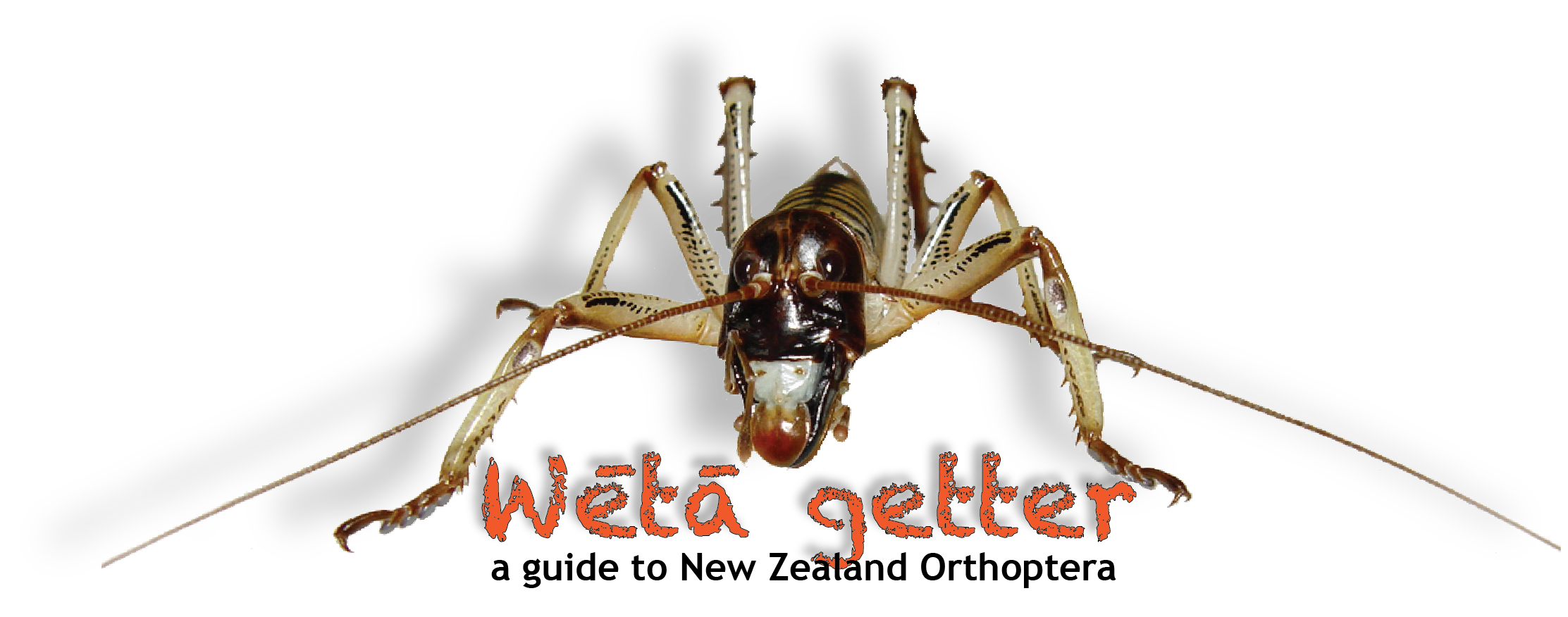|

Most New Zealand grasshoppers live above the tree line, and are routinely frozen under the winter snow cap. They are globally unusual in that they survive winter in this torpor at all life stages – egg, nymph or adult,  then reanimate when warmer weather returns. This allows multiplegenerations to be present at any one timeand for species lives to span up to three years (Batchelor, 1967; Hudson, 1970). In contrast many alpine species in other parts of the world overwinter only as eggs, resulting in an annual life cycle with synchronised generations (Batchelor, 1967). New Zealand species are also unusual in that they are sexually dimorphic; females being larger than males at maturity. In some cases (e.g. Brachaspis nivalis, Paprides nitidus, Sigaus australis, Sigaus piliferus and Sigaus villosus) this difference can be two-fold (Bigelow, 1967; Hudson, 1970). All species of the endemic New Zealand genera are flightless, have no ears and do not sing. then reanimate when warmer weather returns. This allows multiplegenerations to be present at any one timeand for species lives to span up to three years (Batchelor, 1967; Hudson, 1970). In contrast many alpine species in other parts of the world overwinter only as eggs, resulting in an annual life cycle with synchronised generations (Batchelor, 1967). New Zealand species are also unusual in that they are sexually dimorphic; females being larger than males at maturity. In some cases (e.g. Brachaspis nivalis, Paprides nitidus, Sigaus australis, Sigaus piliferus and Sigaus villosus) this difference can be two-fold (Bigelow, 1967; Hudson, 1970). All species of the endemic New Zealand genera are flightless, have no ears and do not sing.
There are six genera of short horned grasshoppers (Orthoptera: Acrididae) in New Zealand: Alpinacris, Brachaspis, Locusta, Paprides, Phaulacridium and Sigaus; four of which are endemic to New Zealand. All four of these endemic genera may be found in the South Island of New Zealand, with only one species of the genus Sigaus found in the North Island and one species of the genus Paprides found on Stewart Island (Bigelow, 1967). Alpinacris, Brachaspis and Paprides are included in the acridid subfamily Cantantopinae (von Wattenwyl, 1893) (Eades et al., 2014). Sigaus, however, is currently placed in the subtribe Russalpiina in Catantopini (von Wattenwyl, 1893) (Key, 1993; Eades et al., 2014). Acrididae is a large family, containing some 10,000 species within a complex taxonomic classification system, and members of Catantopinae are found throughout Australia, Asia, Europe and Africa. Subtribe Russalpiina are restricted to New Zealand and the Australian island of Tasmania (Eades et al., 2014a).
 In 1897, Hutton described 10 species under the above four genera. Fifty years later a new member was added to this group (Sigaus villosus = Brachaspis villosus). New Zealand acridid taxonomy was reviewed by Bigelow (1967), and the addition of Sigaus childi Jamieson 1999, S. takahe Morris 2003 and S. homerensis Morris 2003, brought the total species count in the four endemic genera to 16: Alpinacris crassicauda, A. tumidicauda, Brachaspis collinus, B. nivalis, B. robustus, Paprides dugdali, P. nitidus, Sigaus australis, S. campestris, S. childi, S. homerensis, S. minutus, S. obelisci, S. piliferus, S. takahe and S. villosus. In 1897, Hutton described 10 species under the above four genera. Fifty years later a new member was added to this group (Sigaus villosus = Brachaspis villosus). New Zealand acridid taxonomy was reviewed by Bigelow (1967), and the addition of Sigaus childi Jamieson 1999, S. takahe Morris 2003 and S. homerensis Morris 2003, brought the total species count in the four endemic genera to 16: Alpinacris crassicauda, A. tumidicauda, Brachaspis collinus, B. nivalis, B. robustus, Paprides dugdali, P. nitidus, Sigaus australis, S. campestris, S. childi, S. homerensis, S. minutus, S. obelisci, S. piliferus, S. takahe and S. villosus.
 Recent molecular work however has revealed disharmony between these morphologically described species and their genetic groupings (clades), with the taxonomy of Brachaspis and Sigaus being called into question. Sigaus australis is better treated as a complex with S. childi, S. homerensis, S. obelisci, and S. species-A. In fact there is little support for S. homerensis, S. obelisci or S. species-A; all three appear to be localised representations of the more widespread species Sigaus australis. Genetic mixture between S. australis and the rare microendemic S. childi has been demonstrated by genetic analysis (Trewick 2008, Dowle et al. 2014). Despite clear phenotypic differences, there is extensive gene flow between the two species where they occur in sympatry and this appears to an example of speciation with gene flow. A similar phenomenon may explain the rare, protected and morphologially distinctive microendemic Brachaspis robustus, which is genetically inseparable from B. nivalis (Trewick 2001). Current niche modelling, morphometric and molecular work will aid in distinguishing exact groupings and relationships within and between New Zealand endemic grasshoppers. Recent molecular work however has revealed disharmony between these morphologically described species and their genetic groupings (clades), with the taxonomy of Brachaspis and Sigaus being called into question. Sigaus australis is better treated as a complex with S. childi, S. homerensis, S. obelisci, and S. species-A. In fact there is little support for S. homerensis, S. obelisci or S. species-A; all three appear to be localised representations of the more widespread species Sigaus australis. Genetic mixture between S. australis and the rare microendemic S. childi has been demonstrated by genetic analysis (Trewick 2008, Dowle et al. 2014). Despite clear phenotypic differences, there is extensive gene flow between the two species where they occur in sympatry and this appears to an example of speciation with gene flow. A similar phenomenon may explain the rare, protected and morphologially distinctive microendemic Brachaspis robustus, which is genetically inseparable from B. nivalis (Trewick 2001). Current niche modelling, morphometric and molecular work will aid in distinguishing exact groupings and relationships within and between New Zealand endemic grasshoppers.

References:
Batchelor CL. 1961. Preliminary observations of alpine grasshoppers ina habitat modified by deer and chamois. Proceedings of the New Zealand Ecological Society, 14:15-26
Bigelow RS. 1967. The grasshoppers of New Zealand, their taxonomy and distribution. University of Canterbury Publications, Christchurch, New Zealand.
Dowle EJ, Morgan-Richards M. & Trewick SA. 2014. Morphological differentiation despite gene flow in an endangered grasshopper. BMC Evolutionary Biology, 14: 216-231
Eades DC, Otte D, Cigliano MM. & Braun H. 2014. Family Acrididae MacLeay, 1821. Orthoptera Species File. Version 5.0/5.0. Retrieved on: December 8th, 2014: http://orthoptera.speciesfile.org/Common/basic/
Goldberg J, Morgan-Richards M, Trewick SA. 2015. Intercontinental island hopping: colonization and speciation of the grasshopper genus Phaulacridium (Orthoptera: Acrididae) in Australasia. Zoologisher Anzeiger 255: 71–79.
Hutton FW. 1897. The grasshoppers and locusts of New Zealand and the Kermadec Islands. Proceedings and Transactions of the New Zealand Institute, 30: 135-150
Hudson L. 1970. Identification of the immature stages of New Zealand apine acridid grasshoppers (Orthoptera). Transactions of the Royal Society of New Zealand: Biological Sciences, 12: 185-20
Jamieson CD. 1999. A new species of Sigaus from Alexandra, New Zealand (Orthoptera: Acrididae). New Zealand Journal of Zoology, 26: 43-48
Key KHL. & Colless DH. 1993. A higher classification of the Australian Acridoidea (Orthoptera). II. *Subfamily Cantanopinae. Invertebrate Systematics, 7: 89-111
Koot EM, Morgan-Richards, M, Trewick SA. 2020. An alpine grasshopper radiation older than the mountains, on Kā Tiritiri o te Moana (Southern Alps) of Aotearoa (New Zealand). Molecular Phylogenetics and Evolution 147: 106783
Morris SJ. 2003. Two new species of Sigaus from Fiordland, New Zealand (Orthoptera: Acrididae). The New Zealand Entomologist, 26: 65-74
Salmon JT. 1950. A new species of Acrididae (Insecta: Orthoptera) from New Zealand. Transactions of the Royal Society of New Zealand, 78: 69
Sivyer L, Morgan-Richards M, Koot E, Trewick SA. 2018. Anthropogenic cause of range shifts and gene flow between two grasshopper species revealed by environmental modelling, geometric morphometrics and population genetics. Insect Conservation & Diversity 11: 415–434.
Trewick SA. 2001. Identity of an endangered grasshopper (Acrididae: Brachaspis): taxonomy, molecules and conservation. Conservation Genetics, 2: 233-243
Trewick SA & Morris S. 2008. Diversity and taxonomic status of some New Zealand grasshoppers. DOC Research and Development Series No. 290, Department of Conservation, Wellington, New Zealand, 40p.
Trewick SA. 2008. DNA Barcoding is not enough: mismatch of taxonomy and genealogy in New Zealand grasshoppers (Orthoptera: Acrididae). Cladistics 24: 240-254.
von Wattenwyl KB. & Fea L. 1893. Révision du système des orthoptères et description des espèces rapportées par M. Leonardo Fea de Birmanie. Vol. 33. Tipografia dei R. Istituto sordo-muti.
|
|


 then reanimate when warmer weather returns. This allows multiplegenerations to be present at any one timeand for species lives to span up to three years (Batchelor, 1967; Hudson, 1970). In contrast many alpine species in other parts of the world overwinter only as eggs, resulting in an annual life cycle with synchronised generations (Batchelor, 1967). New Zealand species are also unusual in that they are sexually dimorphic; females being larger than males at maturity. In some cases (e.g. Brachaspis nivalis, Paprides nitidus, Sigaus australis, Sigaus piliferus and Sigaus villosus) this difference can be two-fold (Bigelow, 1967; Hudson, 1970). All species of the endemic New Zealand genera are flightless, have no ears and do not sing.
then reanimate when warmer weather returns. This allows multiplegenerations to be present at any one timeand for species lives to span up to three years (Batchelor, 1967; Hudson, 1970). In contrast many alpine species in other parts of the world overwinter only as eggs, resulting in an annual life cycle with synchronised generations (Batchelor, 1967). New Zealand species are also unusual in that they are sexually dimorphic; females being larger than males at maturity. In some cases (e.g. Brachaspis nivalis, Paprides nitidus, Sigaus australis, Sigaus piliferus and Sigaus villosus) this difference can be two-fold (Bigelow, 1967; Hudson, 1970). All species of the endemic New Zealand genera are flightless, have no ears and do not sing. In 1897, Hutton described 10 species under the above four genera. Fifty years later a new member was added to this group (Sigaus villosus = Brachaspis villosus). New Zealand acridid taxonomy was reviewed by Bigelow (1967), and the addition of Sigaus childi Jamieson 1999, S. takahe Morris 2003 and S. homerensis Morris 2003, brought the total species count in the four endemic genera to 16: Alpinacris crassicauda, A. tumidicauda, Brachaspis collinus, B. nivalis, B. robustus, Paprides dugdali, P. nitidus, Sigaus australis, S. campestris, S. childi, S. homerensis, S. minutus, S. obelisci, S. piliferus, S. takahe and S. villosus.
In 1897, Hutton described 10 species under the above four genera. Fifty years later a new member was added to this group (Sigaus villosus = Brachaspis villosus). New Zealand acridid taxonomy was reviewed by Bigelow (1967), and the addition of Sigaus childi Jamieson 1999, S. takahe Morris 2003 and S. homerensis Morris 2003, brought the total species count in the four endemic genera to 16: Alpinacris crassicauda, A. tumidicauda, Brachaspis collinus, B. nivalis, B. robustus, Paprides dugdali, P. nitidus, Sigaus australis, S. campestris, S. childi, S. homerensis, S. minutus, S. obelisci, S. piliferus, S. takahe and S. villosus. Recent molecular work however has revealed disharmony between these morphologically described species and their genetic groupings (clades), with the taxonomy of Brachaspis and Sigaus being called into question. Sigaus australis is better treated as a complex with S. childi, S. homerensis, S. obelisci, and S. species-A. In fact there is little support for S. homerensis, S. obelisci or S. species-A; all three appear to be localised representations of the more widespread species Sigaus australis. Genetic mixture between S. australis and the rare microendemic S. childi has been demonstrated by genetic analysis (Trewick 2008, Dowle et al. 2014). Despite clear phenotypic differences, there is extensive gene flow between the two species where they occur in sympatry and this appears to an example of speciation with gene flow. A similar phenomenon may explain the rare, protected and morphologially distinctive microendemic Brachaspis robustus, which is genetically inseparable from B. nivalis (Trewick 2001). Current niche modelling, morphometric and molecular work will aid in distinguishing exact groupings and relationships within and between New Zealand endemic grasshoppers.
Recent molecular work however has revealed disharmony between these morphologically described species and their genetic groupings (clades), with the taxonomy of Brachaspis and Sigaus being called into question. Sigaus australis is better treated as a complex with S. childi, S. homerensis, S. obelisci, and S. species-A. In fact there is little support for S. homerensis, S. obelisci or S. species-A; all three appear to be localised representations of the more widespread species Sigaus australis. Genetic mixture between S. australis and the rare microendemic S. childi has been demonstrated by genetic analysis (Trewick 2008, Dowle et al. 2014). Despite clear phenotypic differences, there is extensive gene flow between the two species where they occur in sympatry and this appears to an example of speciation with gene flow. A similar phenomenon may explain the rare, protected and morphologially distinctive microendemic Brachaspis robustus, which is genetically inseparable from B. nivalis (Trewick 2001). Current niche modelling, morphometric and molecular work will aid in distinguishing exact groupings and relationships within and between New Zealand endemic grasshoppers. 

